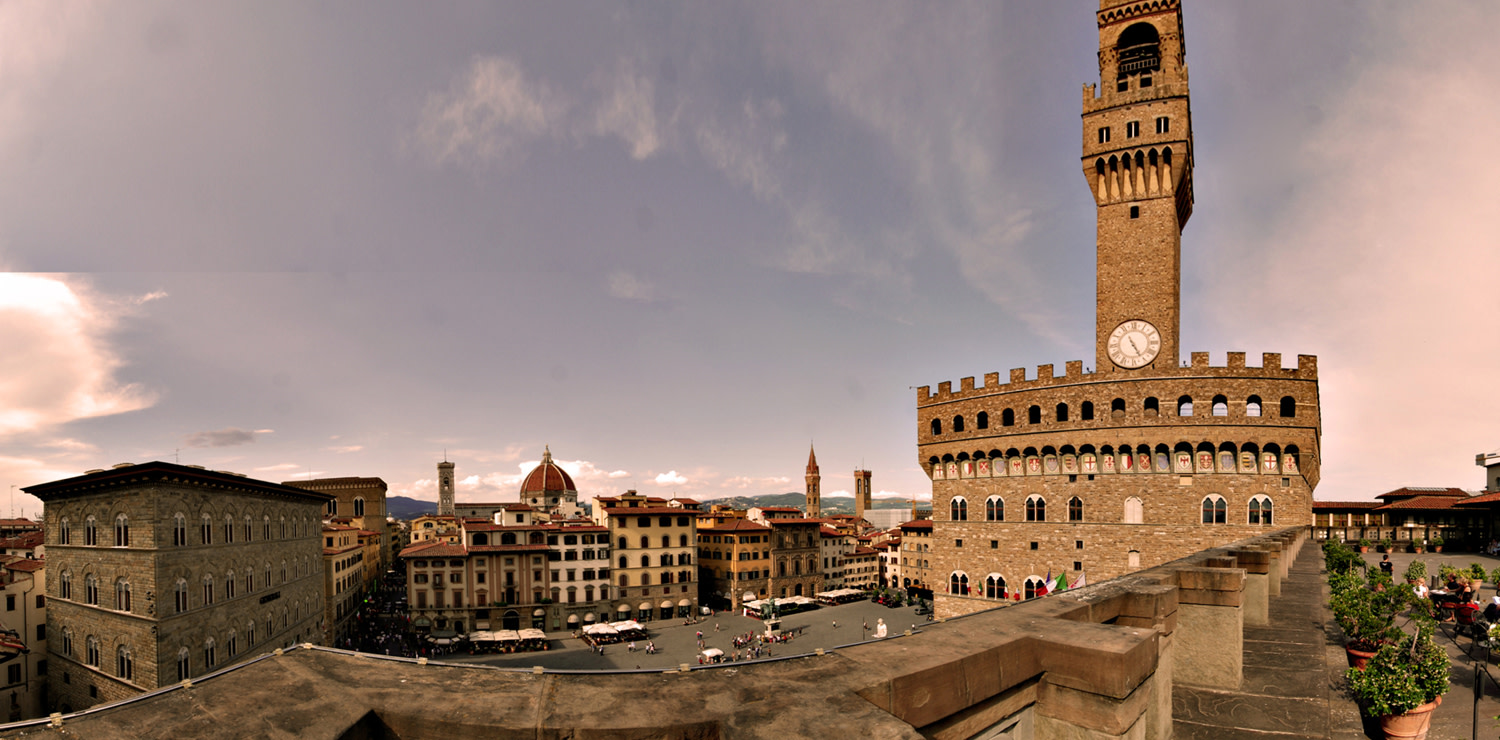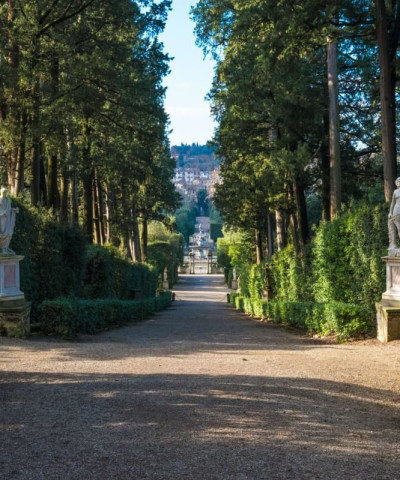Secrets of the Palazzo Vecchio
A special itinerary to discover the historic palace in Florence
Palazzo dei Priori or Palazzo Ducale? Palazzo della Signoria or just Palazzo Vecchio, the stronghold’s name as soon as the Medici left their old palace to move to the more comfortable Pitti Palace? The first enigma lies in the palazzo’s name, but this is not the only question about the building, as intriguing as it is imbued in stories and stratifications. Indeed it’s what makes the Palazzo Vecchio so appealing.
Palazzo Vecchio is the fortified core of Florence, erected in 1299 based on plans attributed to Arnolfo di Cambio. The building stands on top of the ancient ruins of the Roman theatre of Florentia, completed in the 1st century AD, now seen along a route that winds underground the palazzo whose entrance is located beneath the ticket office. In the place where the oldest hub of Florentia we also find medieval Florence, the time machine par excellence, suspended in space by just a few minutes – the time it takes to walk the underground passage – projected into the city of corporations and councils.
Designed to accommodate the government of the city council and later the Florentine Republic, consisting of members appointed by the city’s guilds (priors), subsequently the Palazzo Vecchio was extended towards via dei Leoni, before the Duke of Athens bestowed upon it the look of a fortress and then, even more distinctively, the construction of the enormous hall, now known as the Hall of the Five Hundred. However, the golden age of the building coincides with the moment when the Medici family chose it as their home. The year was 1540: the young Duke Cosimo I arrived at the palazzo with his wife Eleanor of Toledo. The austere medieval fortress was forced to change in order to foist upon the people the enlightened and impressive power of the Medici. The architect Giorgio Vasari was called to the court to interpret Cosimo’s vision, and the work began. The most conspicuous changes involved the Hall of the Five Hundred, built in the late 1400s on the commission of Girolamo Savonarola, who hoped for greater dialogue between power and subjects; the room’s great height was modified on Cosimo’s instructions. The sense of space, strategically placed windows, columns and niches that celebrate the Medici dynasty transform the hall into a magnificent Throne Room. The side walls, where we can still gaze at the frescos of the victorious battles against Pisa and Siena, which laud Florentine and the family’s power, are part of an exciting slice of history that involved Leonardo and Michelangelo in the early 16th century. Both artists were summoned to paint the hall but did not finish their commissions. From time to time art historians search for traces of the masters’ work, which might even lie beneath Vasari’s painting, which is what we see today.
From the Hall of the Five Hundred we can gain access (a modern change; access was not possible in the past) to the Studiolo of Francesco I, a confined space devoid of any visible windows where Francesco I, Cosimo’s son cultivated his interest in the arts and experimental science. It was also a storage space for the more rare and precious specimens of his collection of natural curiosities as well as small engineering works. Decorated between 1570 and 1575 by a group of artists led by Giorgio Vasari, according to themes articulated by Vincenzo Borghini, the room is covered entirely in allusions to the relationship between art and nature and also to the materials comprising the rarities kept in the cabinets concealed in the walls. One of these panels opens into an entranceway to another small room used by Duke Cosimo as an office or treasury. This is the first of the Secret Passages discovered when visiting the palazzo’s 16th-century halls. Not included in the normal museum tour but accessible on special visits upon reservation, these were passages used exclusively by the Medici family and a few privileged guests. Today’s Secret Passages tour allows visitors to walk as far as beneath the palazzo’s roofs and to look out over the trusses that hold up the impressive ceiling of the Hall of the Five Hundred, a masterpiece of Renaissance engineering and carpentry.
A strong and ambitious principality like Cosimo I’s opened out to the world to demonstrate its power: the Quarters of Leo X and the Rooms of the Elements are the two symmetrical floors of the palazzo intended to receive guests to the court and designed to flaunt its greatness. The lower level is dedicated to the terrestrial (“dei terrestri”) focusing on the Medici dynasty, while the upper level (“dei celesti”) is dedicated to ancient mythology: both floors display a surprising weft of painting orchestrated by Vasari and the court scholars, forming a direct or indirect ode to Cosimo and his forefathers. Symbols and allegories interweave with real historical events, clothing the dynasty in an almost divine air. Adjacent to the representative quarters, the Ducal Apartments are the most private part of the palazzo, intended for use by the family. The decorations in the green apartment of Eleanor of Toledo are pleasingly graceful, with the private chapel frescoed by Bronzino. The beautiful Eleanor moved to Florence, leaving the sun of Naples behind, and Cosimo sought to make her life more enjoyable in the austere building by adding loggias and spectacular terraces within its walls, with magnificent views over the city.
On the second floor the Hall of the Lilies, the ancient Chancellery, with portraits of the famous Machiavelli that recall its original use, the Hall of Geographical Maps, or “Wardrobe”, in which prestigious items from the Medici Collections were stored around the oldest large globe ever known, are all important places in the history of the city and act as a prelude to the climb up the Torre di Arnolfo, which with its 95 metres in height towers over the city, surpassing by law all other towers belonging to Florentine nobility. Up the 406 steps that lead to the top of the tower you first come across the wall walk with its breath-taking views and then the Alberghetto, Florence’s most secret prison where Girolamo Savonarola spent his last days.
One last curiosity: there’s a mezzanine between the first and second floor, which dates to the Middle Ages but was modified by Michelozzo just after the mid 1500s. The mezzanine was once the living quarters of Maria Salviati resided, Cosimo I’s mother. Today these rooms display a valuable collection of paintings and sculptures donated to the city by the American art historian Charles Loeser in 1928. A friend of another collector, Herbert Percy Horne, Loeser chose Florence as his second home and celebrated his Renaissance soul for the whole of this life, as seen in these rooms.













